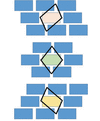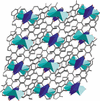issue contents
June 2021 issue

Cover illustration: Cocrystals of the antimalarial drug 11-azaartemisinin (11-Aza) with salicylic acid (SalA) were reported recently and showed an enhanced dissolution rate. The use of bromo-substituted SalA compounds has now allowed the isolation of a larger family of these 1:1 cocrystals. All the structures involve molecular pairs with R22(8) heterosynthons between the 11-Aza lactam functionality and the benzoic acid group that are organized into highly preserved 21 stacks. These are organized into either isostructural (5-BrSalA) or modified arrangements (4-BrSalA and 3,5-Br2SalA), with varying degrees of homostructurality compared to the parent SalA cocrystal. See Roy, Li, Nisar, Wong, Sung, Haynes & Williams [Acta Cryst. (2021), C77, 262–270].
research papers










Unique octahedral rotation pattern in the oxygen-deficient Ruddlesden–Popper compound Gd3Ba2Fe4O12








 journal menu
journal menu

























